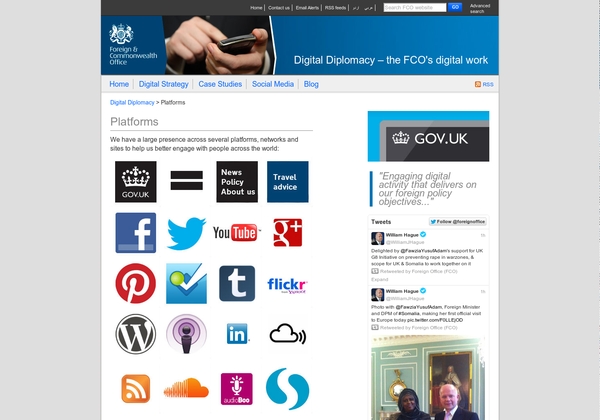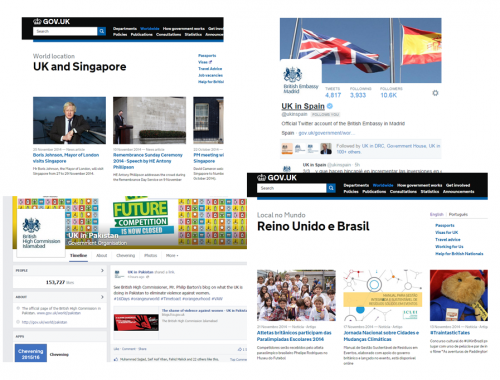28th November 2014 London, UK
Reviewing the digital work of our embassies – part 2

This blog post looks at what we learnt from our recent review of how our embassies around the world are using digital.
In our 2014 digital review we asked posts (embassies, high commissions, consulates etc) to assess how they were using digital tools and techniques in four areas: communications; strategic planning and leadership; policy making; and services. Posts were asked to self-assess using a competence framework.
Our posts ranked themselves on average as strongest on digital communications, with particular strengths in using digital communications for major events and using appropriate channels to deliver relevant messages. We found that posts felt they were weaker on detailed digital landscaping and in evaluation, though they were seeking to develop their skills in these areas.
Posts ranked themselves fairly highly on leadership with many saying that their senior management either uses digital tools or champion their use. This is in line with the striking growth of our senior officials on social media, up from 3 ambassadors and senior officials on twitter in 2010 to 130 now.
The majority of our posts rated themselves relatively highly in using digital tools to improve service delivery. Digital now features prominently in crisis planning and posts provide up-to-date consular information for British nationals through digital. Posts considered themselves weakest at using digital to help improve policy work. Although an increasing number of staff are using digital to help inform their policy making there is still more to be done to give colleagues the skills, confidence and IT that they need to do this effectively.
Overall, the results suggested that posts scored most highly where: senior management takes an interest and leads by example; digital is appropriately resourced and the main digital officer has a background in digital or has been properly trained; and digital is widely understood and used across the whole of the mission.
We also asked posts to tell us how we could better help them in their digital work. The main things included better guidance and training, including on analytics and evaluation; improved central co-ordination of communications around major policy issues; more advance notice of communications to allow time for translation; and more visual content.
Happily these are areas on which we’ve already been working. We will shortly be launching a new digital training curriculum which will address some of these needs. We will also be issuing new guidance on digital evaluation. Our communications directorate is working to ensure better planning of communications priorities overseas. And we are also increasing the quantity of visual content and infographics (and welcome them from our posts too!)
Finally, as part of the review, we asked posts for examples of best practice. We received more than 100 examples and will be sharing them with colleagues across the globe. Some of the examples have already appeared on this blog and we will be adding others over the coming months.
There is a lot of work still to be done but we believe that this has been a valuable exercise. Posts have told us that they found it useful. We now understand what is working well and less well. We know what posts need from us. We’ve given posts a framework which they can continue to use to shape their digital work. And hopefully we have inspired posts to do more through the sharing of best practice.
